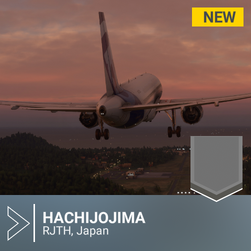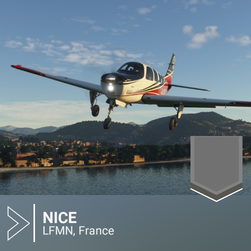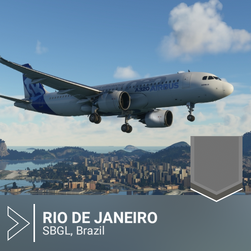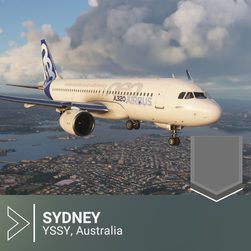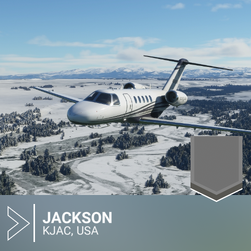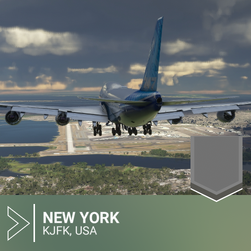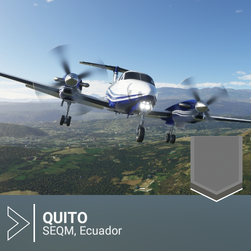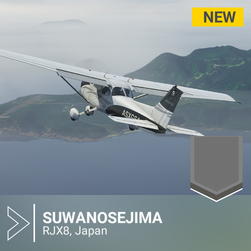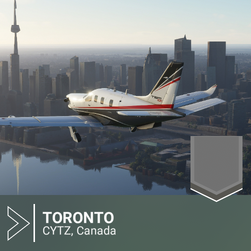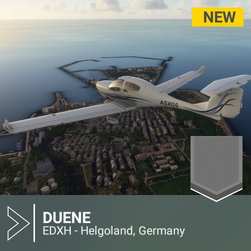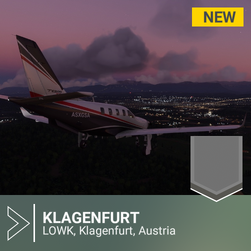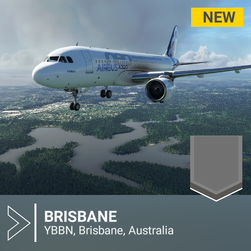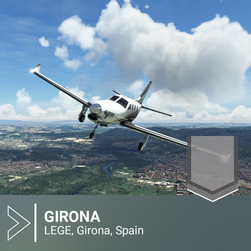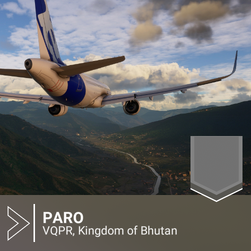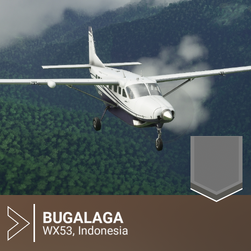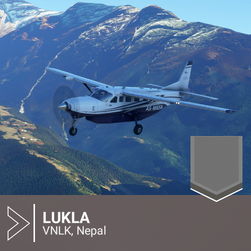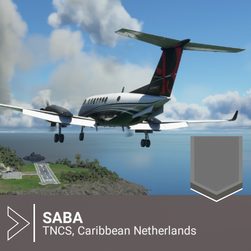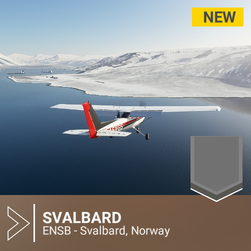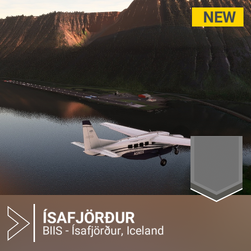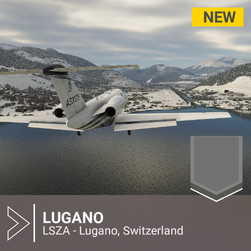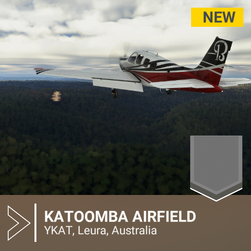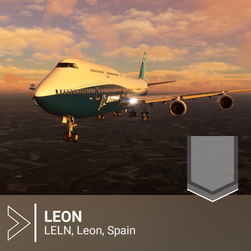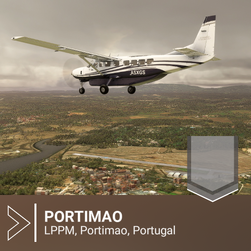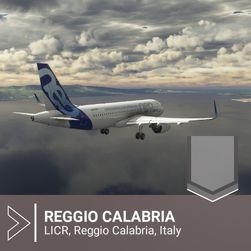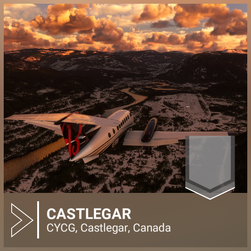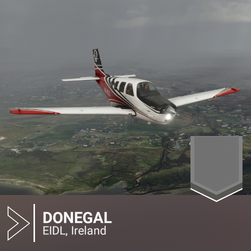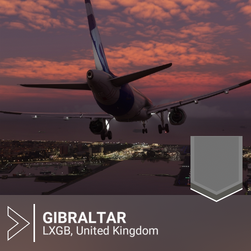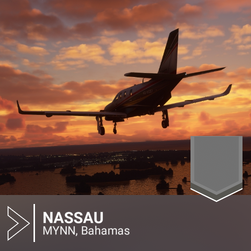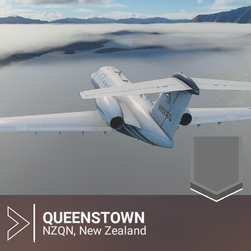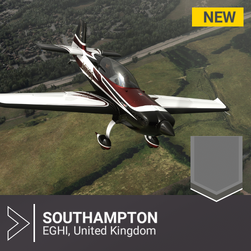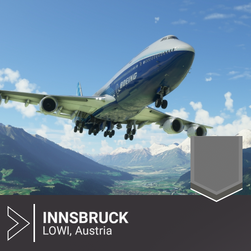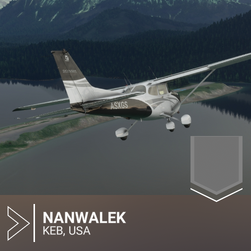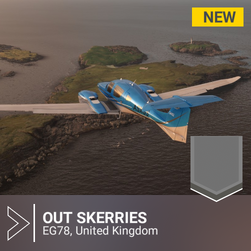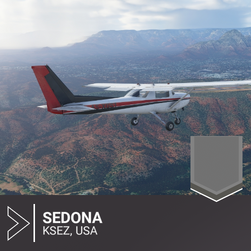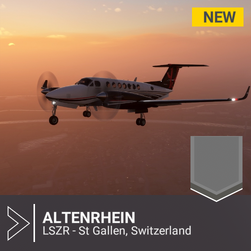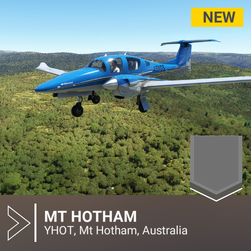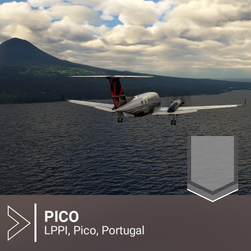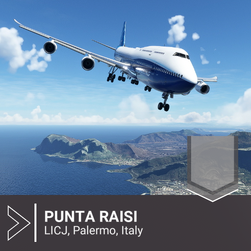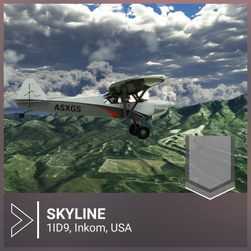FS2020: Landing Challenges
Landing Challenges in Microsoft Flight Simulator (2020) are a set of activities which test a pilot's ability to land as close to certain pre-defined parameters as possible. As of World Update XI: Canada (WU11) (2022-09-28), there are 58 unique Landing Challenges.
Each landing challenge consists of a predefined airport, runway, aircraft, and weather conditions. The objective is to attempt to perform as close to a perfect landing as possible.
During the loading screen a suggested approach path is displayed. It includes the targeted approach speed and at the bottom includes the judgement criteria. The challenge begins with fully setup and in-flight along the approach. Once the airport is in sight, a blue box is displayed on the runway which marks the target touchdown point.
Scoring
Each landing is scored using three criteria:
- Landing precision: The distance between the center of the touchdown zone and your touchdown. Maximum score: 5,000 points
- Ground roll: The distance to runway centerline from your touchdown to your full stop. Maximum score: 5,000 points
- Landing smoothness: The descent rate just before and at your touchdown. Maximum score: 200 points
The formula used to calculate the overall score is (landing precision score + ground roll score) * landing smoothness score. The maximum score for each challenge is therefore (5,000 + 5,000) * 200 = 2,000,000 points.
Categories
There are currently three categories of Landing Challenges.
- Famous challenges act as an introduction to the system with as airport and aircraft pairings that are easy-to-moderate in difficulty.
- "Well-known locations and challenges that are well within reach. Focus on fundamental landing techniques, precision and smoothness."
- Epic challenges are a step up in difficulty with difficult approaches and runway configurations.
- "Short airstrips, treacherous terrain, dramatic approaches and harrowing descents. Face the most iconic and dangerous places to land in the world."
- Strong Wind challenges add difficulty by way of strong crosswinds, often of variable direction by altitude and featuring gusts.
- "Strong winds make a pilot's job even harder. Contend with air currents and crosswinds along the approach path to ensure a good landing."
List of Landing Challenges
Famous Challenges
Hachijojima
| “ | 187 miles south of Tokyo, the compound volcanic island of Hachijojima rises in the Philippine Sea. The island's regional airport, established in 1926 by the Imperial Japanese Navy, lies nestled between two volcanic peaks and presents pilots with a standard approach for airliners — however moderately high crosswinds coming from the south can make landing even a nimble A320neo a bit more challenging. | ” |
- Airplane: Airbus A320neo
- Airport: Hachijojima Airport ()
- ICAO: RJTH
- Arrival: Rwy 08 — 6560 ft long @ 283 ft MSL
Llanada Grande
| “ | Llanada Grande Airport is a small public-use airfield in the Los Lagos Region of the Chile. Its small size makes it primarily suitable for small aircraft, and its mountainous locale can turn the approach into a challenge for the unprepared pilot. | ” |
- Airplane: Cessna 172 Skyhawk (G1000)
- Airport: Llanada Grande Airport ()
- ICAO: SCLD
- Arrival: Rwy 32 — 3632 ft long @ 1041 ft MSL
Nice
| “ | Nice Côte d'Azur Airport is a bustling international airport located 3.2 nautical miles southwest of Nice, France. As the principal port of arrival for visitors to the French Riviera and Monaco, it stands as one of the most spectacular landing sites in the world. The approach isn't especially difficult, but pilots will have to align with Runway 22R and keep parameters stale to touch-down in the best conditions. | ” |
- Airplane: Beechcraft Bonanza G36
- Airport: Nice Côte d'Azur Airport ()
- ICAO: LFMN
- Arrival: Rwy 22R — 8431 ft long @ 13 ft MSL
Rio De Janeiro
| “ | Rio de Janeiro-Antonio Carlos Jobim/Galeao International Airport, located on an island in Guanabara Bay, sis the main airport serving Rio and a central gateway to Brazil. En route to Runway 33, pilots are treated to one of the most scenic approaches in the world — and while a landing here won't be exceedingly difficult, a perfect landing of an A320 is not so easy to achieve. | ” |
- Airplane: Airbus A320neo
- Airport: Rio de Janeiro/Galeão International Airport ()
- ICAO: SBGL
- Arrival: Rwy 33 — 10434 ft long @ 13 ft MSL
Sydney
| “ | Situated on an open oceanic embayment of Botany Bay, Sydney Kingsford Smith International Airport is one of the longest continuously-operated commercial airfields in the world. Though the approach to Runway 16R is quite straightforward, landing an A320 in one of the largest airports in Australia under the best conditions is still a challenge for most pilots. | ” |
- Airplane: Airbus A320neo
- Airport: Sydney Kingsford Smith Airport ()
- ICAO: YSSY
- Arrival: Rwy 16R — 12997 ft long @ 7 ft MSL
Jackson
| “ | At the base of the spectacular Teton Mountain Range in Wyoming lies Jackson Hole Airport. This remote airfield may be known for its awe-inspiring setting, however its high altitude, short runway and rapidly changing weather conditions are truly what make pilots take notice, and take extra care. | ” |
- Airplane: Cessna Citation CJ4
- Airport: Jackson Hole Airport ()
- ICAO: KJAC
- Arrival: Rwy 19 — 6305 ft long @ 6451 ft MSL
New York
| “ | John F. Kennedy International Airport is the busiest international air passenger gateway into North America. Despite its proximity to the bustling boroughs of New York City, the approach to JFK isn't particularly difficult — unless you're contending with the notable weight and increase momentum of a Boeing 747, which makes every landing quite an achievement. | ” |
- Airplane: Boeing 747-8 Intercontinental
- Airport: John F. Kennedy International Airport ()
- ICAO: KJFK
- Arrival: Rwy 31L — 14510 ft long @ 16 ft MSL
Quito
| “ | Mariscal Sucre International Airport is the busiest airport in Ecuador and one of the busiest in South America. Located near the Ecuadorian capital of Quito, the airport offers a relatively straight-forward approach — however, with a runway elevation of 7,874 feet, pilots will be wise to keep a close eye on aircraft performance. | ” |
- Airplane: Beechcraft King Air 350i
- Airport: Mariscal Sucre International Airport ()
- ICAO: SEQM
- Arrival: Rwy 18 — 13417 ft long @ 7773 ft MSL
Suwanosejima
| “ | Sparsely and sporadically-populated for several thousand years, through multiple historic volcanic eruptions, Suwanoose-jima is the second-largest island of the Tokara Archipelago. Its small airfield sees no regularly-scheduled flights on its notable short 2,300-foot landing strip, but pilots on approach are treated to a stunning view of one of the most active stratovolcanoes in Japan. | ” |
- Airplane: Cessna 172 Skyhawk (G1000)
- Airport: Suwanosejima Airport ()
- ICAO: RJX8
- Arrival: Rwy 32 — 2699 ft long @ 251 ft MSL
Toronto
| “ | Billy Bishop Toronto City Airport is a regional facility serving the financial and tourist districts of Toronto, the provincial capital of Ontario, Canada. While there is no trick to landing a TBM 930 on Runway 26, a magnificent approach past the city's downtown corridor and over Toronto Harbour allow pilots to practice and perfect their landing skills. | ” |
- Airplane: Daher TBM 930
- Airport: Billy Bishop Toronto City Airport ()
- ICAO: CYTZ
- Arrival: Rwy 26 — 4106 ft long @ 252 ft MSL
Arlanda
| “ | Stockholm Arlanda Airport is a major international airport located in the town of Märsta, 20 nautical miles north of the Swedish capital of Stockholm. The airport, the largest and busiest in the country, comprises three runways, and is surrounded by low swaths of forest and farmland. | ” |
- Airplane: Boeing 747-8 Intercontinental
- Airport: Stockholm Arlanda Airport ()
- ICAO: ESSA
- Arrival: Rwy 01L — 10786 ft long @ 99 ft MSL
Rønne
| “ | Bornholm Airport is located on the southwestern corner of the Danish island of Bornholm in the Baltic Sea. The single 6,530-foot-long runway lies just a few hundred yards from crashing surf on its south edge, with low, flat fields and swaths of trees just inland of it. | ” |
- Airplane: Cessna Citation CJ4
- Airport: Bornholm Airport ()
- ICAO: EKRN
- Arrival: Rwy 29 — 6539 ft long @ 51 ft MSL
Düne
| “ | Heligoland Airport — Düne, Germany: Located on the uninhabited island of Düne, the smaller of the two islands of the Heligoland archipelago in the North Sea, Heligoland Airport offers remarkable views as well as challenges to those landing here. You'll be treated to magnificent vistas of sea and shoreline as you skirt the southern edge of Heligoland, the larger of the two islands, on your base leg. Then, due to the short length of the runway and winds of the area, prepare to coordinate between throttle, flaps, and other controls with precision once on final—and then carefully apply brakes once you touch down. |
” |
- Airplane: Diamond DA40 NG
- Airport: Heligoland Airport ()
- ICAO: EDXH
- Arrival: Rwy 03 — 1376 ft long @ 3 ft MSL
Klagenfurt
| “ | Located in southern Austria, just 15 miles north of the border with Slovenia, Klagenfurt Airport lies nestled at the base of a shallow bowl surrounded by rolling mountains. While situated amid gentle terrain, the weather here can prove treacherous, making landings challenging, especially at dusk. When thunderstorms and other weather is present, take great care once on final due to wind gusts, especially during low light hours. |
” |
- Airplane: Daher TBM 930
- Airport: Klagenfurt Airport ()
- ICAO: LOWK
- Arrival: Rwy 10L — 8917 ft long @ 1452 ft MSL
Brisbane
| “ | Brisbane Airport is an international facility that serves the city of Brisbane and surrounding regions in the Australian state of Queensland. Located on the shore of Moreton Bay, which opens to the South Pacific's Coral Sea, Brisbane Airport is the third busiest airport in Australia with over twenty million served each year. While the approach is straightforward onto Runway 01, the sheer size of the Airbus A320neo requires each control input and throttle change to be made with great care to maintain a smooth descent onto the ground. |
” |
- Airplane: Airbus A320neo
- Airport: Brisbane Airport ()
- ICAO: YBBN
- Arrival: Rwy 01R — 11671 ft long @ 12 ft MSL
Shellharbour
| “ | Shellharbour is a regional airport located just inland of Lake Illawarra in eastern New South Wales, Australia. It is roughly fifty miles south-southwest of Sydney and one hundred miles northeast of the national capital, Canberra. The two-runway airport lies within a beautiful setting of distant mountains, patchworks of suburban architecture, and the large Lake Illawara. Landing on Runway 16 is straightforward and presents only moderate challenges while offering stunning views of the region. |
” |
- Airplane: Daher TBM 930
- Airport: Shellharbour Airport ()
- ICAO: YSHL
- Arrival: Rwy 16 — 5964 ft long @ 22 ft MSL
Girona
| “ | Located just under 15 miles from the Mediterranean Coastline in northeastern Spain, Girona-Costa Brava Airport serves the region of Costa Brava and the Pyrenees mountains. It is also used as an alternative to Barcelona's main air hub, Josep Tarradellas Barcelona – El Prat Airport. Although surrounded by mountains, the peaks are low, presenting minimal dangers. Using the city of Girona as a landmark, make an easy turn to the south-southwest and come in for a picture perfect landing in one of the Iberian Peninsula's most beautiful regions. |
” |
- Airplane: Daher TBM 930
- Airport: Girona-Costa Brava Airport ()
- ICAO: LEGE
- Arrival: Rwy 19 — 7860 ft long @ 474 ft MSL
Bilbao
| “ | Bilbao Airport, an international facility which serves the municipality of Bilbao in northern Spain, lies just under ten miles from the Bay of Biscay. Beginning your approach from southeast of the airport, pass through light atmospheric conditions, including mist, and then make your final approach by turning onto a northwesterly course. Smooth control inputs will result in a textbook landing of the Airbus. |
” |
- Airplane: Airbus A320neo
- Airport: Bilbao Airport ()
- ICAO: LEBB
- Arrival: Rwy 30 — 8539 ft long @ 130 ft MSL
Hartsfield-Jackson Atlanta
| “ | Hartsfield–Jackson Atlanta International Airport is an international facility located 8 miles south-southwest of downtown Atlanta, Georgia, which it primarily serves. Originally established in 1926 as Candler Field, a 287-acre municipal airport, it is today the world’s busiest airport by passenger traffic, seeing more than 75 million people move through its gates per year. KATL, 4,700 acres in size and comprising five parallel runways, also has the world’s largest airline hub and is considered the first “mega-hub” in the United States, meaning that it offers multiple domestic and international connections. Built big to accommodate the world’s largest aircraft, KATL is ideally suited for the Boeing 747-8, especially 12,390-foot runway 27R. Pilots nevertheless need to pay close attention to the controls on the jumbo jet, to not overcorrect, and also keep a keen eye on the runway during approach to the busy facility. |
” |
- Airplane: Boeing 747-8 Intercontinental
- Airport: Hartsfield-Jackson Atlanta International Airport ()
- ICAO: KATL
- Arrival: Rwy 27 — 12394 ft long @ 997 ft MSL
Calgary Intl.
| “ | CYYC, Calgary International Airport, is the busiest airport in the province of Alberta and the third busiest in Canada, serving over six million passengers per year. It is located 5 miles north-northeast of downtown Calgary and is surrounded by highways, subdivisions, and a few small lakes on open, flat plains. The airport is composed of four runways, including two parallel runways, 17R\/35L and 17L\/35R, which can possibly cause confusion. The challenge begins with the nose of the Airbus A320neo aimed directly at McDonald lake in the distance on the landing’s base leg. The lake, which is located 5 miles to the northeast of the touchdown point of Runway 17R, is a great visual reference. Closer to the runway, the cloverleaf interchange of Alberta Highway 2 and Alberta Provincial Highway No. 201, is another excellent reference. Turn onto final, keeping the lake, the interchange—and Runway 17L—to the left. Sight the airport tower to the east and downtown Calgary to the west, with Runway 17R between the two, and ease the Airbus gently onto the ground. |
” |
- Airplane: Airbus A320neo
- Airport: Calgary International Airport ()
- ICAO: CYYC
- Arrival: Rwy 17R — 12672 ft long @ 3555 ft MSL
Epic Challenges
Aspen
| “ | Aspen/Pitkin County Airport, also known as Sardy Field, is a high-altitude regional airport nestled in the Colorado Rocky Mountains. To land on Runway 33, pilots must contend with a steep approach through the area's mountainous terrain, and a strong chance of bad weather obscuring the path. | ” |
- Airplane: Cessna Citation CJ4
- Airport: Aspen-Pitkin County Airport ()
- ICAO: KASE
- Arrival: Rwy 33 — 8007 ft long @ 7840 ft MSL
Courchevel
| “ | Situated in the French Alps, Courchevel Altiport is a small mountainous aerodrome serving the ultra-exclusive ski resort community of Courchevel. The airfield, famous for its difficult approach and extremely short, upward-sloping runway, is made even more challenging with no go-around procedure due to the treacherous surrounding rocky terrain. | ” |
- Airplane: Daher TBM 930
- Airport: Courchevel Airport ()
- ICAO: LFLJ
- Arrival: Rwy 22 — 1788 ft long @ 6371 ft MSL
Paro
| “ | In the Kingdom of Bhutan, in a deep valley on the bank of the river Paro Chhu, amidst the towering Himalaya Mountains, stands Paro International Airport. With surrounding peaks as high as 18,000 feet, and runway carved out of mountain foliage situated a mile and half above sea level, this is widely considered one of the most challenging airports in the world. | ” |
- Airplane: Airbus A320neo
- Airport: Paro International Airport ()
- ICAO: VQPR
- Arrival: Rwy 15 — 7428 ft long @ 7354 ft MSL
Saint-Barthelemy
| “ | Gustaf III Airport is a public use airfield located on the Caribbean island of Saint Barthelemy. Its short runway lies at the base of a gentle slope and ends directly on the beach — but the real trick here is the approach, obscured behind a hill that forces pilots into and extremely steep descent if they want to land. | ” |
- Airplane: Daher TBM 930
- Airport: Gustaf III Airport ()
- ICAO: TFFJ
- Arrival: Rwy 10 — 2107 ft long @ 48 ft MSL
Bugalaga
| “ | In aviation circles, the Indonesian province of Papua is infamous for its poorly-maintained mountainous airstrips, which are often the only points of contact between locals and the outside world. Bugalaha, with its precipitously steep, sloped, and short runway, is no exception. | ” |
- Airplane: Cessna 208 B Grand Caravan EX
- Airport: Bugalaga Airstrip ()
- ICAO: WX53
- Arrival: Rwy 24 — 1648 ft long @ 6121 ft MSL
Lukla
| “ | Tenzing-Hillary Airport is a small but popular airfield in eastern Nepal, drawing countless visitors each year on a quest to reach Mount Everest Base Camp. For pilots, the airport is one of the most difficult landing spots, with high winds, cloud cover, no go-around option, and a short, sloped runway that ends unforgivingly at a large stone wall. | ” |
- Airplane: Cessna 208 B Grand Caravan EX
- Airport: Tenzing-Hillary Airport ()
- ICAO: VNLK
- Arrival: Rwy 06 — 1776 ft long @ 9180 ft MSL
Saba
| “ | Located on the Dutch Caribbean island of Saba, Juancho E. Yrausquin Airport has one of the shortest commercial runways in the world at only 1,312 feet long. To add to that, the airstrip is flanked on one side by high hills, with both ends terminating at steep drop-offs into the sea, giving pilots plenty of peril to contend with while landing. | ” |
- Airplane: Beechcraft King Air 350i
- Airport: Juancho E. Yrauquin Airport ()
- ICAO: TNCS
- Arrival: Rwy 30 — 977 ft long @ 115 ft MSL
Tegucigalpa
| “ | Toncontín International Airport is a civil and military airfield located 4 miles from the center of Tegucigalpa, Honduras. Its proximity to rugged mountainous terrain and its short runway make the airport one of the most difficult in the world, especially when inclement weather conditions prevail. | ” |
- Airplane: Airbus A320neo
- Airport: Toncontín International Airport ()
- ICAO: MHTG
- Arrival: Rwy 02 — 6638 ft long @ 3300 ft MSL
Svalbard
| “ | Svalbard Airport is a single-runway domestic airport located on the west coast of Svalbard, an archipelago in the Arctic Ocean roughly midway between the northern coast of Norway and the North Pole. At just over 78 degrees north latitude, this is the northernmost airport in the world with regularly scheduled passenger service. The 8,146-foot-long runway lies just inland of the icy waters of Advent Bay, set amid truly spectacular scenery of mountains, glaciers, and fjords. This landscape, as beautiful as it is, can prove tricky for pilots landing at Svalbard, especially with the area's fickle weather. |
” |
- Airplane: Cessna 152
- Airport: Svalbard Airport ()
- ICAO: ENSB
- Arrival: Rwy 10 — 8174 ft long @ 70 ft MSL
Ísafjörður
| “ | Ísafjörður Airport is a small, regional airport that serves the remote Westfjords aspect of northwestern Iceland. Its single, 4,570-foot-long runway is tucked into the southeast nook of a fjord, making landing here tricky. It requires pilot nimbleness and precision while flying inside the tight confines of the surrounding topography. Once at your base leg, which lies deep within the fjord, turn hard left, fly for less than a nautical mile, and then make another tight left turn and line up to stick the landing! |
” |
- Airplane: Cessna 208 B Grand Caravan EX
- Airport: Ísafjörður Airport ()
- ICAO: BIIS
- Arrival: Rwy 08 — 4570 ft long @ 8 ft MSL
Lugano
| “ | Located in the far south of Switzerland, just here miles from the border with Italy, Lugano Airport is set amid beautiful lakes and steep terrain and is near some of the highest mountains in Europe, including Monte Rosa and the Matterhorn. Due to its topography and unpredictable winds, landing here can prove challenging. Focus is key, as your eyes will want to wander off to the beautiful vistas as you approach the runway flying over Lake Lugano on final. |
” |
- Airplane: Cessna Citation CJ4
- Airport: Lugano Airport ()
- ICAO: LSZA
- Arrival: Rwy 01 — 4643 ft long @ 898 ft MSL
Katoomba
| “ | Katoomba Airfield is a dirt airstrip located in New South Wales in southeastern Australia. The strip is cut into dense forest atop a plateau in the Blue Mountains approximately fify miles west-northwest of Sydney. Katoomba is one of Australia's most challenging airfields for landing due to its rough nature, relatively short length of just 3,100 feet, and altitude of 3,301 feet above sea level. The stands of forest surrounding it on all sides add to the airfield's danger, necessitating pilots pay close attention to their altitude and speed just before touching down. |
” |
- Airplane: Beechcraft Bonanza G36
- Airport: Katoomba Airfield ()
- ICAO: YKAT
- Arrival: Rwy 07 — 3188 ft long @ 3311 ft MSL
Mabuiag Island
| “ | Mabuiag Island Airport is a single-runway facility on tiny Mabuiag Island in far northern Queensland, Australia. Located in the Torres Strait, the island lies roughly fifty miles south of the island of New Guinea, and is one of the northernmost airports in Australia. The runway is built onto a small isthmus on the northeastern extremity of the island, and at 1,494 feet in length, is the shortest in the country. One of the most beautiful airports in Australia, Mabuiag Island Airport is also one of the most challenging and hazardous at which to land due to its short length. Pilots need to exercise great caution as well as quick action and precision to touch down here, as there is little room for error. |
” |
- Airplane: Cessna 208 B Grand Caravan EX
- Airport: Mabuiag Island Airport ()
- ICAO: YMAA
- Arrival: Rwy 15 — 1494 ft long @ 33 ft MSL
Leon
| “ | León Airport is a small domestic aviation facility that lies outside the northern Spanish town of León, roughly 70 miles south of the coastline of the Bay of Biscay. At an altitude of 3,005 feet above sea level, it is the highest airport in the Iberian Peninsula. While not at an extreme height, the airport definitely can prove challenging, notably in larger aircraft, and especially during low light conditions. Approaching the airport from the southwest, turn nearly 90 degrees onto a northeasterly heading for final. Pay very close attention to glide slope, control inputs, and be ever vigilant to not over correct, and you'll bring the 747-8 safely back to the ground at León. |
” |
- Airplane: Boeing 747-8 Intercontinental
- Airport: León Airport ()
- ICAO: LELN
- Arrival: Rwy 05 — 9815 ft long @ 2994 ft MSL
Portimao
| “ | Portimão Airport is a small, single-runway facility located in southern Portugal just inland of Baia de Lagos, part of the Gulf of Cadiz. Popular with skydivers, Portimão is surrounded by beautiful pastoral landscapes. Due to the runway's length, just 2,870 feet, landing here often proves a tough challenge. Heading west-northwest, turn 90 degrees onto your base leg, and then quickly make another 90-degree turn onto final, paying close attention to altitude during the procedure to ensure a trouble-free touchdown in the Grand Caravan. |
” |
- Airplane: Cessna 208 B Grand Caravan EX
- Airport: Portimão Airport ()
- ICAO: LPPM
- Arrival: Rwy 11 — 2816 ft long @ 5 ft MSL
Reggio Calabria
| “ | Reggio Calabria Airport is a civil / military dual-use facility in the southern Italian city of Reggio Calabria. Also called 'Airport of the Strait', it lies on the shore of the Strait of Messina, which separates Sicily and the Italian Peninsula, and connects the Ionian and Tyrrhenian Seas in the heart of the Mediterranean. Established in 1939, the airport today comprises two asphalt runways and handles over 5,000 aircraft movements per year. Approaching from the sea and turning onto final just one mile to the southeast of Runway 33, the landing is reminiscent of that at Hong Kong Kai Tak Airport, when it was still in use. Be easy on the controls with your turn onto final, as you won't have any time to correct, and you'll bring the A320neo nicely onto the runway. |
” |
- Airplane: Airbus A320neo
- Airport: Reggio Calabria Airport ()
- ICAO: LICR
- Arrival: Rwy 33 — 6553 ft long @ 31 ft MSL
Sestri
| “ | Genoa Airport, which is also called Christopher Columbus Airport (and informally, Genoa-Sestri Ponente Airport), is located three miles west of the city center of Genoa, in northwest Italy. The facility has a single asphalt runway which is built atop an artificial peninsula along the coast of the Gulf of Genoa, part of the Mediterranean's Ligurian Sea. Keep a keen eye out to the west just before turning onto final as the airport lies in the shadows of the mountains during this early morning landing, making it difficult to spot. Once lined up, ease the Cessna CJ4 onto Runway 28 for a picture perfect landing amid stunning, early morning scenery. |
” |
- Airplane: Cessna Citation CJ4
- Airport: Genoa Cristoforo Colombo Airport ()
- ICAO: LIMJ
- Arrival: Rwy 28 — 9580 ft long @ 12 ft MSL
Telluride
| “ | In term of both objective hazards and beauty, few airports can match KTEX, Telluride Regional Airport. The single-runway facility serves the southwestern Colorado town of Telluride, which lies in the heart of the high, remote, and very rugged San Juan Mountains, part of the greater Rocky Mountains of the western United States. Telluride’s 7,111-foot-long asphalt runway lies at an elevation of 9,078 feet above sea level, ranking it as the second highest airport in the United States (behind Colorado’s Leadville, which lies at 9,934’ AMSL). The runway, located five miles west of the town of Telluride, also slopes slightly and abruptly ends in a cliff on its western end. It is located on the shoulder of 13,496-foot-high Mears Peak, which forms part of the northern periphery of the box canyon in which Telluride, and its airport, lies. Despite the dangers, this is one of the most beautiful mountain regions in the United States, and evening lighting often accentuates the wild topography and clouds above with golden and pink hues. Pay close attention during approach, carefully eyeing the western end of the runway and the cliff at its edge. Be prepared to be quick on the controls, but without overcorrecting. There is little room for error when landing at KTEX. |
” |
- Airplane: Daher TBM 930
- Airport: Telluride Regional Airport ()
- ICAO: KTEX
- Arrival: Rwy 9 — 7106 ft long @ 9307 ft MSL
Castlegar
| “ | Castlegar Airport, formally called West Kootenay Regional Airport, is a single-runway facility located in southern British Columbia, 20 miles north of the border with the United States. It lies along the Columbia River, two miles southeast of the town of Castlegar. Surrounded by peaks of the Selkirk Mountains and subject to fickle winds and weather conditions, Castlegar is known as one of Canada’s most challenging airports. Starting off over the Columbia River, turn onto final approach by heading over land just to the east of the river. Line up, being careful not to overcorrect, and ease the King Air onto Runway 33. The runway’s light dusting in snow makes attention to all control inputs, even the smallest, absolutely critical, from just before touching down, until stopped. |
” |
- Airplane: Beechcraft King Air 350i
- Airport: Castlegar Airport ()
- ICAO: CYCG
- Arrival: Rwy 33 — 5289 ft long @ 1616 ft MSL
Strong Wind Challenges
Donegal
| “ | In the northwest corner of Ireland, in the townland of Carrickfinn, Donegal Airport is a single-runway airfield situated on the spectacular Wild Atlantic Way. While this coastal position blessed the region with some of the island's most beautiful scenery, direct exposure to the Atlantic also brings sweeping winds from across the ocean. | ” |
- Airplane: Beechcraft Bonanza G36
- Airport: Donegal Airport ()
- ICAO: EIDL
- Arrival: Rwy 21 — 4905 ft long @ 102 ft MSL
Gibraltar
| “ | Gibraltar International Airport is a civilian airfield serving the British overseas territory of Gibraltar, situated on the border with Spain. As strong crosswinds whip across the Bay of Algeciras and around the Rock of Gibraltar, pilots can expect abnormal gusts, turbulence and wind shear to spike the difficulty of landing here. | ” |
- Airplane: Airbus A320neo
- Airport: Gibraltar International Airport ()
- ICAO: LXGB
- Arrival: Rwy 09 — 5789 ft long @ 11 ft MSL
Kerama
| “ | Far south of mainland Japan, beyond Okinawa, the Kerama Archipelago is a veritable tropical paradise. Amid vibrant "Kerama Blue" waters, the uninhabited island of Fukaji-jima is home to two things: a whale observatory, and the Kerama Airport. Pilots trying to land on the short 2,617-foot runway that spans the island should brace for alternate approaches as the airport's locationi n the East China Sea routinely confronts them with strong gusts and tailwinds. | ” |
- Airplane: Cessna 208 B Grand Caravan EX
- Airport: Kerama Airport ()
- ICAO: ROKR
- Arrival: Rwy 20 — 2617 ft long @ 160 ft MSL
Nassau
| “ | Located on the island of New Providence, near the capital city of Nassau, Lynden Pindling International Airport is the main international gateway to the Bahamas — but be prepared, the approach path to paradise is often swept by high winds. | ” |
- Airplane: Daher TBM 930
- Airport: Lynden Pindling International Airport ()
- ICAO: MYNN
- Arrival: Rwy 28 — 8298 ft long @ 13 ft MSL
Queenstown
| “ | Queenstown Airport, located in New Zealand, is a popular aerodrome for tourist 'flightseeing' around the resort region of Queenstown. Perched on the edge of a lake at the confluence of three mountain valleys, its runway is squeezed between peaks reaching more than 5,000 feet, presenting pilots with likely strong, gusty and variable winds on approach. | ” |
- Airplane: Cessna Citation CJ4
- Airport: Queenstown Airport ()
- ICAO: NZQN
- Arrival: Rwy 05 — 6209 ft long @ 1160 ft MSL
Southampton
| “ | Flying into Southampton International Airport is no easy feat, especially in the EXTRA 330LT on an extremely windy day. An aircraft designed as an acrobatic tourer, the 330LT is remarkably light, making it nimble but also susceptible to strong gusts. After joining the traffic pattern on the downwind leg, pilots will find the plane's lack of flaps requires a shallow approach at a faster speed — adding to the challenge of navigating these turbulent skies about the United Kingdom and coming in for a safe landing. | ” |
- Airplane: EXTRA 330LT
- Airport: Southampton Airport ()
- ICAO: EGHI
- Arrival: Rwy 20 — 5651 ft long @ 44 ft MSL
Funchal
| “ | Located in Santa Cruz, in the Portuguese archipelago of Madeira, Cristiano Ronaldo Madeira International Airport is a marvel of structural engineering, with its runway perched on a foreland jutting out to sea. It's also considered one of the most peculiarly perilous airports in the world due to this extreme positioning — and that says nothing of the added challenge when severe off-shore winds rise up. | ” |
- Airplane: Airbus A320neo
- Airport: Cristiano Ronaldo Madeira International Airport ()
- ICAO: LPMA
- Arrival: Rwy 05 — 9126 ft long @ 144 ft MSL
Innsbruck
| “ | Nestled high in the Austrian Alps, Innsbruck is a seasonally-busy international airport primarily serving the ski and alpine industry. Due to its location in a deep mountain valley, the approach and descent process is a complicated and demanding one, made even more difficult by vicious winds and currents bourne from imposing mountain terrain. | ” |
- Airplane: Boeing 747-8 Intercontinental
- Airport: Innsbruck Airport ()
- ICAO: LOWI
- Arrival: Rwy 26 — 6552 ft long @ 1893 ft MSL
Nanwalek
| “ | Nanwalek Airport is a state-owned, public-use airfield in the remote Alaskan community formerly known as English Bay. Boasting one of the shortest runways in the USA, its approach is further complicated by an abrupt mountain to the south and regular exposure to stiff winds. | ” |
- Airplane: Cessna 172 Skyhawk (G1000)
- Airport: Nanwalek Airport ()
- ICAO: KEB
- Arrival: Rwy 01 — 2153 ft long @ 33 ft MSL
Out Skerries
| “ | Amongst the Shetland Islands in far northern Scotland, on the tiny landmass of Bruray, sits Out Skerries Airfield and its 1,200-foot long gravel runway, rated one of the shortest in the world. To land a DA62 at this isolated airstrip, pilots must content with subarctic winds and waves on the tumultuous North Sea, navigate a turn in the approach, and locate a runway nestled in the rocky landscape with no navigational aides or lights — then comes the challenge of touching down and stopping with precision to avoid plunging off the cliff into the frigid waters below. | ” |
- Airplane: Diamond DA62
- Airport: Out Skerries Airstrip ()
- ICAO: EG78
- Arrival: Rwy 09 — 1204 ft long @ 24 ft MSL
Sedona
| “ | Sedona Airport is a small airport situated on a 500 foot tall mesa in Arizona. High elevation, rugged terrain, cliffs, and unique wind patterns present pilots with simultaneous perils, making this one of the most challenging, and most scenic, airports in the United States. | ” |
- Airplane: Cessna 152
- Airport: Sedona Airport ()
- ICAO: KSEZ
- Arrival: Rwy 21 — 5122 ft long @ 4830 ft MSL
Vaasa
| “ | Vaasa Airport is a relatively small international airport that serves the Finnish city of Vaasa. It's located on the western side of the country approximately 20 nautical miles inland of the Baltic Sea's Gulf of Bothnia. Surrounded by flat, beautiful terrain of verdant forests and patchworks of fields, the approach and landing at the single-runway airport is fairly straightforward. The area's weather, notably high winds, however, can really test the skills of pilots, requiring a heightened level of attention, especially to keep from overcorrecting. Once on your base leg, fly for 5.1 nautical miles and turn right onto final approach — and beware those winds! |
” |
- Airplane: Airbus A320neo
- Airport: Vaasa Airport ()
- ICAO: EFVA
- Arrival: Rwy 34 — 8961 ft long @ 12 ft MSL
Düsseldorf
| “ | Located four miles north of downtown Düsseldorf, the capital of the western German state of North Rhine-Westphalia, Düsseldorf is set amid sweeps of fields, forest, and suburbs just two miles east of the Rhine River. While its layout is straightforward, both weather and traffic can prove hazardous in this busy airport. | ” |
- Airplane: Boeing 747-8 Intercontinental
- Airport: Düsseldorf Airport ()
- ICAO: EDDL
- Arrival: Rwy 23L — 9837 ft long @ 140 ft MSL
Altenrhein
| “ | St. Gallen-Altenrhein Airport, a regional facility located in northeastern Switzerland lies just inland of Lake Constance, where the borders of Switzerland, Austria, and Germany meet. The views of approach are spectacular in this northern Alpine location, especially at dusk with the waters of Lake Constance in the distance. As you enjoy the beauty of your surroundings, however, be mindful of your speed and rollout after touching down on this relatively small airport. |
” |
- Airplane: Beechcraft King Air 350i
- Airport: St. Gallen-Altenrhein Airport ()
- ICAO: LSZR
- Arrival: Rwy 28 — 5317 ft long @ 1306 ft MSL
Mt Hotham
| “ | Mount Hotham is a single-runway airport located in the eastern reaches of the Australian state of Victoria. Primarily serving the Hotham Alpine Resort, which is located on the slopes of Mount Hotham in the Australian Alps, the airport ranks as the highest in the country at 4,259 feet above sea level. Surrounded by lush forest, the approach brings endless beautiful vistas, but the mountainous environment also means frequent powerful and erratic winds. Pilots will need to exercise great case on the controls from approach until stopped on the ground to keep ahead of the perils that the area's gusts can bring. |
” |
- Airplane: Diamond DA62
- Airport: Mount Hotham Airport ()
- ICAO: YHOT
- Arrival: Rwy 11 — 4784 ft long @ 4259 ft MSL
Pico
| “ | Pico Airport is a small, single-runway facility on the Portuguese island of Pico, located just over 1,000 miles to the west of Lisbon in the Portuguese Azores. The airport lies on the northwestern extremity of the island, at the base of Mount Pico, a volcano that stands 7,710 feet above the waters of the North Atlantic. Nestled in a beautiful setting, the airport presents challenges, even to the most seasoned of aviators, primarily due to fickle weather conditions, notably the wind. Approaching the airport from the northeast, over the water, turn onto a heading just south of due West as you reach the coastline. Being attentive to gusts, and delicate on the controls in response, will deliver a safe landing. |
” |
- Airplane: Beechcraft King Air 350i
- Airport: Pico Airport ()
- ICAO: LPPI
- Arrival: Rwy 27 — 5240 ft long @ 110 ft MSL
Punta Raisi
| “ | Falcone Borsellino Airport, often referred to by its former name, Punta Raisi Airport, serves the city of Palermo, the capital of Sicily. It is located 15 miles northwest of Palermo, just inland of the shore of the Tyrrhenian Sea in northwestern Sicily. The international facility, the second busiest airport in Sicily with over 40,000 aircraft movements per year, has two asphalt runways. It is known for its temperamental and often extreme winds, making landings here challenging, and sometimes dangerous. The sheer mass of the Boeing 747-8 Intercontinental combined with the strong wind makes this a particularly difficult challenge. Gain a visual on Runway 25 by spotting Pizzo di Mezzo, the prominent, sheer-faced bluff as you begin your approach. The runway lies just over a mile to the north of the mountain. Watch your yaw inputs just prior to and after touching down to maintain a heading straight down the runway, without overcorrecting. |
” |
- Airplane: Boeing 747-8 Intercontinental
- Airport: Falcone Borsellino Airport ()
- ICAO: LICJ
- Arrival: Rwy 25 — 10924 ft long @ 66 ft MSL
Skyline
| “ | In the category of short airstrips in the United States, Skyline, located four miles east of Inkom, Idaho, on five acres of land, may take first place. Only 400 feet in length, 1ID9, also known as Simko Field Airport, can accommodate only a few airframes, namely bush flyers and STOL craft. Skyline is not only short, it lies at over one mile high in elevation. It is also situated atop a sloping ridge, with its high point, at its eastern end, at 5,623 feet above sea level, and its low point, at its western extremity, at 5,567’ AMSL, 56 feet lower. Add a gusty, strong wind—and a light aircraft like an XCub—and a true challenge awaits! | ” |
- Airplane: CubCrafters XCub
- Airport: Simko Field Airport (Skyline Airport) ()
- FAA LID: 1ID9
- Arrival: Rwy 10 — 1111 ft long @ 5568 ft MSL
Barkerville
| “ | Barkerville Airport is a small single-strip airfield located 1.2 miles due north of the town of Barkerville, British Columbia. The airport and town lie on the western periphery of the Cariboo Mountains; Barkerville was founded to support the Cariboo Gold Rush of the 1800s and today is preserved as a ghost town. The airport consists of a single asphalt runway 2,700 feet in length and only 40 feet wide. Nestled into a small valley, locating the airstrip requires careful attention to the lay of the region’s topography. The challenge begins just southwest of Jack of Clubs Lake. Slowly descending, fly over the lake to its northeast extremity, then pass the small village of Wells. Sight the small “island” of trees just northwest of Wells, and then once over them, turn 90 degrees to the southeast into a small valley. British Columbia Highway 26, the 'Barkerville Highway', is a good visual reference, as it heads into the valley, passing just south of the runway. The runway is small, so it only comes into clear view about ¾ of a mile before reaching it. Pay close attention to control inputs in the strong wind to stay lined up with the runway from just before touching down until stopped. The runway’s narrowness doesn’t allow for much side-to-side drift at all. |
” |
- Airplane: Cessna 208 B Grand Caravan EX
- Airport: Barkerville Airport ()
- TC LID: CAS3
- Arrival: Rwy 11 — 2686 ft long @ 3996 ft MSL
History
- Added three Landing Challenges:
- Reggio Calabria — Reggio Calabria Airport () — Airbus A320neo
- ICAO: LICR
- Sestri — Genoa Cristoforo Colombo Airport () — Cessna Citation CJ4
- ICAO: LIMJ
- Punta Raisi — Falcone Borsellino Airport () — Boeing 747-8 Intercontinental
- ICAO: LICJ
- Reggio Calabria — Reggio Calabria Airport (
World Update VIII: Iberia (WU8) (2022-03-24):
- Added five Landing Challenges:
- Girona — Girona-Costa Brava Airport () — Daher TBM 930
- ICAO: LEGE
- Bilbao — Bilbao Airport () — Airbus A320neo
- ICAO: LEBB
- Leon — León Airport () — Boeing 747-8 Intercontinental
- ICAO: LELN
- Portimao — Portimão Airport () — Cessna 208 B Grand Caravan EX
- ICAO: LPPM
- Pico — Pico Airport () — Beechcraft King Air 350i
- ICAO: LPPI
- Girona — Girona-Costa Brava Airport (
World Update VII: Australia (WU7) (2022-01-31):
- Added five Landing Challenges:
- Brisbane — Brisbane Airport () — Airbus A320neo
- ICAO: YBBN
- Shellharbour — Shellharbour Airport () — Daher TBM 930
- ICAO: YSHR
- Mt Hotham — Mount Hotham Airport () — Diamond DA62
- ICAO: YHOT
- Katoomba Airfield — Katoomba Airfield () — Beechcraft Bonanza G36
- ICAO: YKAT
- Mabuiag Island — Mabuiag Island Airport () — Cessna 208 B Grand Caravan EX
- ICAO: YMAA
- Brisbane — Brisbane Airport (
World Update VI: Germany/Austria/Switzerland (WU6) (2021-09-07):
- Added four Landing Challenges:
- Düsseldorf — Düsseldorf Airport () — Boeing 747-8 Intercontinental
- ICAO: EDDL
- Düne — Heligoland Airport () — Diamond DA40 NG
- ICAO: EDXH
- Klagenfurt — Klagenfurt Airport () — Daher TBM 930
- ICAO: LOWK
- Lugano — Lugano Airport () — Cessna Citation CJ4
- ICAO: LSZA
- Altenrhein — St. Gallen-Altenrhein Airport () — Beechcraft King Air 350i
- ICAO: LSZR
- Düsseldorf — Düsseldorf Airport (
World Update V: Nordics Europe (WU5) (2021-06-17):
- Added five Landing Challenges:
- Rønne — Bornholm Airport () — Cessna Citation CJ4
- ICAO: EKRN
- Ísafjörður — Ísafjörður () — Beechcraft King Air 350i
- ICAO: BIIS
- Arlanda — Stockholm Arlanda () — Boeing 747-8 Intercontinental
- ICAO: ESSA
- Svalbard — Svalbard () — Cessna 152
- ICAO: ENSB
- Vaasa — Vaasa () — Airbus A320neo
- ICAO: EFVA
- Rønne — Bornholm Airport (
World Update III: United Kingdom (WU3) (2021-02-16):
- [Undocumented] Added one Landing Challenge:
- Southampton — Southampton Airport () — EXTRA 330LT
- ICAO: EGHI
- Southampton — Southampton Airport (
World Update II: USA (WU2) (2020-11-24):
- [Undocumented] Added one Landing Challenge:
- Out Skerries — Out Skerries Airstrip () — Diamond DA62
- LID: EG78
- Out Skerries — Out Skerries Airstrip (
World Update I: Japan (WU1) (2020-09-29):
- Added three Landing Challenges:
- Hachijojima &mdash Hachijojima Airport () — Airbus A320neo
- ICAO: RJTH
- Suwanosejima — Suwanosejima Airport () — Cessna 172 Skyhawk (G1000)
- LID: RJX8
- Kerama — Kerama Airport () — Cessna 208 B Grand Caravan EX
- ICAO: ROKR
- Hachijojima &mdash Hachijojima Airport (
PC Release (2020-08-18):
- [Undocumented] Added one Landing Challenge:
- Courchevel — Courchevel Airport () — Daher TBM 930
- ICAO: LFLJ
- Courchevel — Courchevel Airport (
Closed beta (2020-07-28):
- Introduced Landing Challenges to the simulator along with following locations:
- Jackson — Jackson Hole Airport () — Cessna Citation CJ4
- ICAO: KJAC
- Llanada Grande — Llanada Grande Airport () — Cessna 172 Skyhawk (G1000)
- ICAO: SCLD
- New York — John F. Kennedy International Airport () — Boeing 747-8 Intercontinental
- ICAO: KJFK
- Nice — Nice Côte d'Azur Airport () — Beechcraft Bonanza G36
- ICAO: LFMN
- Quito — Mariscal Sucre International Airport () — Beechcraft King Air 350i
- ICAO: SEQM
- Rio de Janeiro — Rio de Janeiro/Galeão International Airport () — Airbus A320neo
- ICAO: SBGL
- Sydney — Sydney Kingsford Smith Airport () — Airbus A320neo
- ICAO: YSSY
- Toronto — Billy Bishop Toronto City Airport () — Daher TBM 930
- ICAO: CYTZ
- Aspen — Aspen-Pitkin County Airport () — Cessna Citation CJ4
- ICAO: KASE
- Bugalaga — Bugalaga Airstrip () — Cessna 208 B Grand Caravan EX
- LID: WX53
- Lukla — Tenzing-Hillary Airport () — Cessna 208 B Grand Caravan EX
- ICAO: VNLK
- Paro — Paro International Airport () — Airbus A320neo
- ICAO: VQPR
- Saba — Juancho E. Yrauquin Airport () — Beechcraft King Air 350i
- ICAO: TNCS
- Saint-Barthelemy — Gustaf III Airport () — Daher TBM 930
- ICAO: TFFJ
- Tegucigalpa — Toncontín International Airport () — Airbus A320neo
- ICAO: MHTG
- Donegal — Donegal Airport () — Beechcraft Bonanza G36
- ICAO: EIDL
- Funchal — Cristiano Ronaldo Madeira International Airport () — Airbus A320neo
- ICAO: LPMA
- Gibraltar — Gibraltar International Airport () — Airbus A320neo
- ICAO: LXGB
- Innsbruck — Innsbruck Airport () — Boeing 747-8 Intercontinental
- ICAO: LOWI
- Nanwalek — Nanwalek Airport () — Cessna 172 Skyhawk (G1000)
- FAA LID: KEB
- Nassau — Lynden Pindling International Airport () — Daher TBM 930
- ICAO: MYNN
- Queenstown — Queenstown Airport () — Cessna Citation CJ4
- ICAO: NZQN
- Jackson — Jackson Hole Airport (
Alpha 2 (2020-04-01):
- [Undocumented] Added one Landing Challenge:
- Sedona — Sedona Airport () — Cessna 152
- LID: KSEZ
- Sedona — Sedona Airport (

